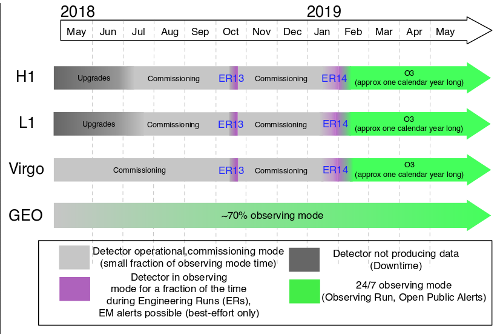Upgrading and commissioning the Virgo detector
As planned, the Virgo and LIGO detectors stopped taking data for the ‘Observation Run 2’ – O2 – on the 25th of August, 2017. For both collaborations, this marked the beginning of a new and busy period, which is scheduled to last at least one year.
During this time, the sensitivity of all three instruments (that is, their ability to detect signals even fainter than those observed in 2015 and 2017 or coming from similar sources, but located further away in the universe) should be improved significantly. Then, in early 2019, the data-taking period – O3 – will start and last for about one calendar year. On the Virgo side, three phases were foreseen.
First, commissioning activities were undertaken until mid-autumn, in order to improve our knowledge of the detector configuration that was used to take data, and to fix issues identified during the August 2017 run. Indeed, for all large facilities such as Virgo, the golden rule is to disturb the instrument as little as possible while it is running. Only issues preventing the taking of data are promptly fixed and only straightforward improvements are allowed. Therefore, it was only after the end of the O2 run that people working in the Virgo control room were able to carry out many different tests and modify the hardware and software configurations of the detector.
Instrument upgrades were implemented from the end of November 2017 until the middle of March 2018. Several pieces of hardware were replaced or modified. Notable upgrades included:
- The installation of a more powerful, ultra-stable input laser: the larger the power circulating in the detector, the more sensitive it is, in particular in the high-frequency range: above a few hundred hertz. With the new laser, the O3 input power is expected to increase by up to a factor of three in comparison with the O2 data-taking period.
- The replacement of the steel wires suspending the mirrors forming the 3-km long Fabry-Perot cavities - four mirrors in total - with fused silica - ‘glass’ - wires. This lower-dissipation material helps in reducing friction at the anchor levels, hence the suspension thermal noise, which represents the dominant fundamental noise impacting upon the Virgo sensitivity in the medium-frequency region, where it is at its best. These fibers have high breaking strengths, but they are fragile, which makes the whole process - from the production of the fibers in a dedicated lab at EGO, to the suspension of the mirror from its superattenuator structure - challenging. In parallel, the vacuum quality has been improved. About a year and half ago, particle contamination of the vacuum caused some fused-silica fibers to break inside the detector. At that time, the mirrors were again suspended from steel wires and the upgrade to fused-silica fibers was postponed to the O2-O3 long shutdown.
- The addition of a squeezed vacuum source - a ’squeezer’ - provided by the Albert Einstein Institute in Hannover, Germany. This instrument, installed at the output port of the interferometer - where the power exists that results from the interference between the laser beams circulating in the 3-km long arms - helps to ’beat’ the quantum noise limit, i.e. to reduce the laser shot-noise, which is dominant at high frequency, below its normal level. This counter-intuitive effect is due to the quantum nature of light: any electromagnetic wave, such as the Virgo laser beam, is defined by two quantities, an amplitude and a phase, both of which are fluctuating. The fluctuations of the phase – also known as ’phase noise’ – matter more than the amplitude fluctuations for Virgo. With a squeezer, one can move part of the phase noise to the amplitude noise – the Heisenberg principle states that one cannot decrease both fluctuations: if one goes down, the other should increase – and hence improve the instrument sensitivity. This technique has been successfully implemented in GEO 600 and LIGO: this is the first time it will be tried in Virgo.

Following the completion of all of these upgrades, Virgo is now back in commissioning mode. The first aim is to learn how to control the detector, which has been significantly modified, and then to improve the sensitivity – by at least a factor of two by the end of the year. This will be challenging but the first results are promising: the best O2 sensitivity – the all-time record sensitivity for Virgo – was surpassed in early June.
